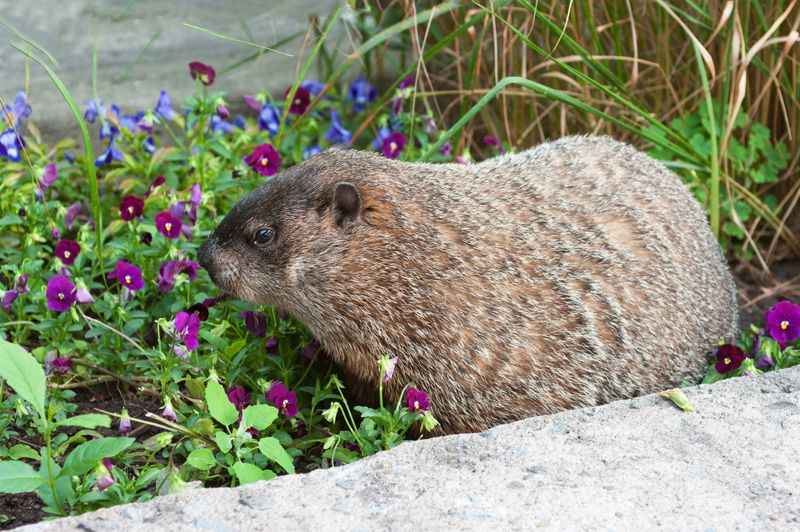
Groundhogs
Groundhogs
Imagine putting in weeks of hard work on your prized crops, nurturing them with so much love only to have a grizzly critter chomp on all the plant species. It hurts bad, doesn’t it? Groundhogs are one of the many species of garden critters, likely to wreak havoc in your gardens. Thus, it is necessary to get rid of them and take preventive measures before the situation gets bad. Depending on where you live, groundhogs may also be called woodchucks, whistle pigs, or marmots. These annoying rodents belong to the squirrel family and greatly resemble gophers in habits and appearance. Even though they are solitary animals, a single groundhog is enough to demolish your entire garden.
Adult groundhogs can grow up to 24 inches long, with a greyish-brown coat and bushy tails. Their short legs hold great power along with sharp claws enabling them to dig extensive underground tunnels. The burrows can be 6 feet deep, and 30 feet long with a mound of soil on one end. Groundhogs majorly feed on plants, consuming approximately one and a half pounds of vegetation each day. That’s a lot! With voracious appetites and their tendency to burrow, groundhogs can soon leave your gardens looking like battlefields. Can you get rid of them? With the right strategies and consistency, you can!
What attracts them to the garden?
Like most critters, access to food, water, and shelter is the major attraction for groundhogs. By understanding what attracts these pesky creatures, you can take timely measures and prevent the groundhogs from getting comfortable in your yards. Let’s discuss in detail the primary factors that attract groundhogs to gardens.
Ample food sources
As exclusive herbivores, groundhogs are particularly attracted to dense, green gardens with an abundance of leafy vegetables. From carrots, peas, and squash to ornamental flowers like pansies and lilies, almost all plant species are at risk of attack.
Even fruits on high branches are not safe from their wrath as they can climb fairly well. Your garden appears as an irresistible open buffet to them.
Accessible water sources
Groundhogs do not need much hydration, given their diet already consists of juicy, green vegetables providing ample moisture. However, during hot, dry periods, an accessible water source is necessary.
Moreover, groundhogs are seasoned swimmers. Thus, your garden with plenty of water bodies, including ponds, fountains, leaking faucets, and birdbaths is an ideal location for these underground critters.
Shelter and protection
Groundhogs prefer overgrown gardens, providing nesting spots and protection from predators. They hibernate during the winter, which makes it even more important to find a safe shelter.
Groundhogs cannot resist dense vegetation, piles of wood and compost, and overgrown weeds. All of this makes your garden an ideal spot for nesting and hibernating during the winter.
How to deter them away?
Now that you know what attracts these unwelcome guests to your garden, you can take effective measures to preserve the integrity of your garden. Here are some practical, tried and tested strategies to limit groundhogs and protect your gardens.
Natural deterrents to keep them away:
Trapping
Live trapping is an effective and humane way of deterring annoying garden critters. Make sure to check your state rules beforehand about relocating groundhogs to avoid any complications. Bait it with young shoots, or with their favorite cantaloupes.
Camouflage the trap with dirt and bushes and place it five feet from the burrow opening. Once the groundhog is captured, release it 4 to 5 miles from your garden.
Fencing
Installing a wire mesh or hardware cloth fence around your garden and even individual plants is an excellent way of keeping the critters away. Make sure you burrow the fence at least 3 feet below the ground, as well as extend it a few feet above the ground for efficient protection.
If you can stretch your budget a bit, consider getting an electric fence. They slightly electrocute the animals whenever they touch the fence, discouraging further damage. The fence should lean outwards from the top so the groundhogs cannot climb over.
Cat litter in burrows
Dumping litter soaked in cat urine in groundhog burrows gives a false impression of the presence of cats. Since cats are their natural predators, they steer away from gardens with cats or even those that smell like cats.
You can also use your pet dog’s poop for the same purpose. However, this can be a tedious task, since you will have to frequently reapply the litter whenever the smell fades away.
Premise of other deterrents
Habitat modification
You can make your garden less appealing to critters by removing or concealing their source of attraction. This includes removing potential nesting spots, filling their burrows with gravel or sand, keeping pet food and bird feeders indoors, and pruning your garden regularly to avoid dense vegetation.
Installing motion-detecting sprinklers or noisemakers can also discourage groundhogs from venturing into your gardens. Groundhogs are intelligent creatures. Once they realize your garden is not a safe space, they are likely to move to a different location.
Repellants
Groundhogs are not a fan of strong scents and rough textures. By applying natural repellents with unpleasant odors or weird tastes, you can effectively deter the groundhogs. Sprinkle Epsom salt on the foliage or mix cayenne pepper, peppermint oil, and castor oil in water and spray the solution throughout the garden.
Ammonia-soaked rags can also do the job since ammonia smells like urine, making them believe there is a predator nearby. Another option is to grow plant species with strong scents, such as mint, rosemary, lavender, and garlic.
Natural predators
Foxes, owls, and coyotes prey on groundhogs, keeping their population in check. By inviting these predators, you can get rid of the groundhogs in your yard, or at least scare them away. Start by installing perches and feeding boxes in your garden to attract natural predators. You can also get a big dog and let it out during the day to hunt groundhogs.
